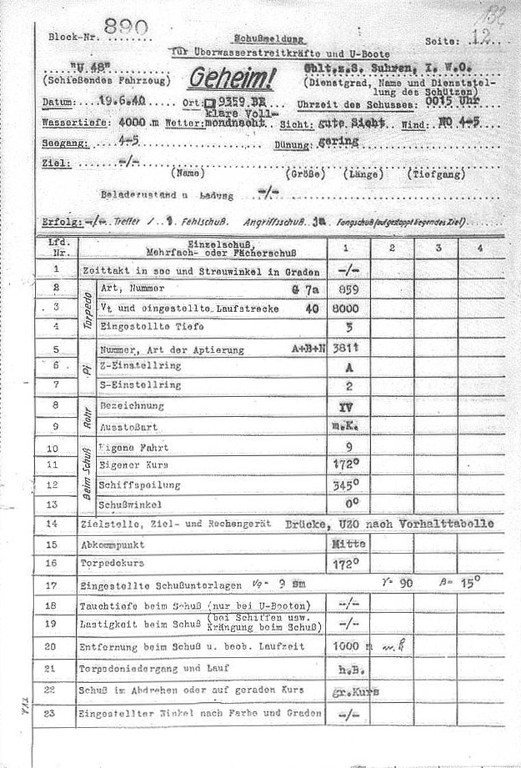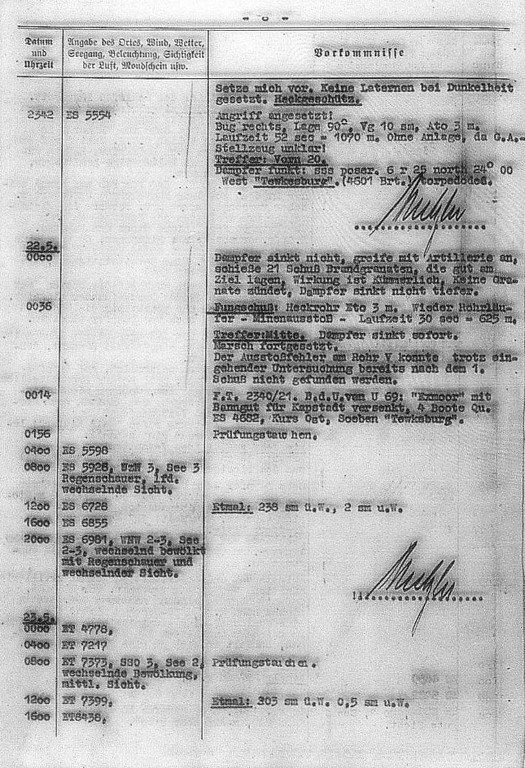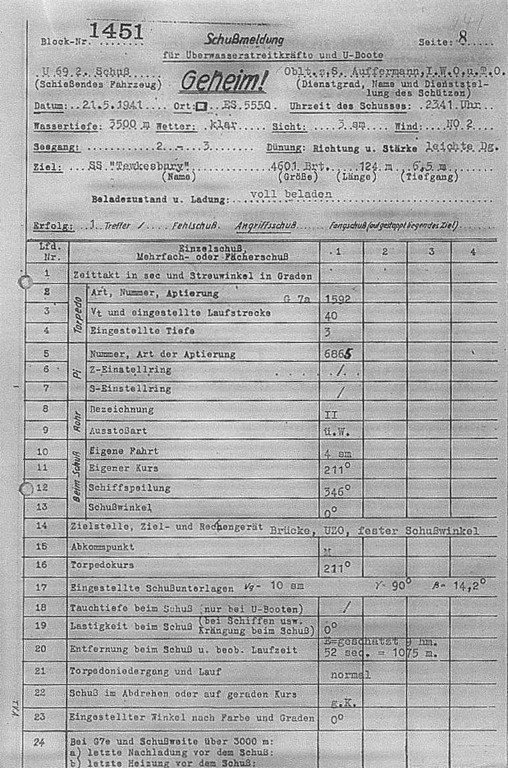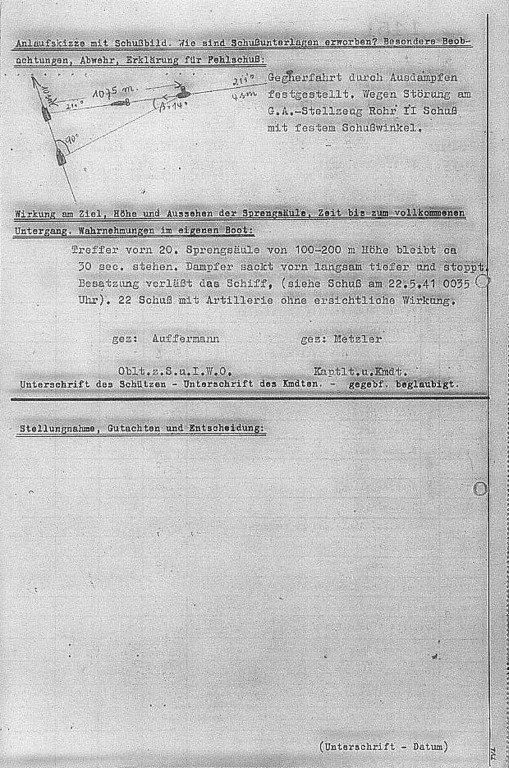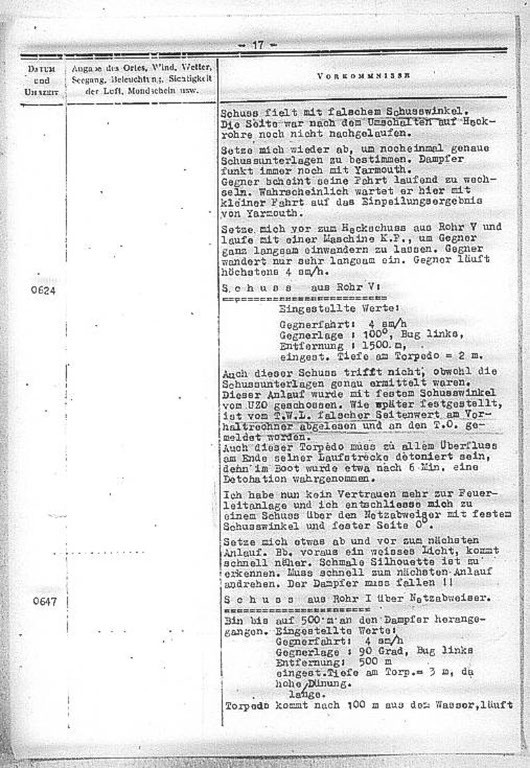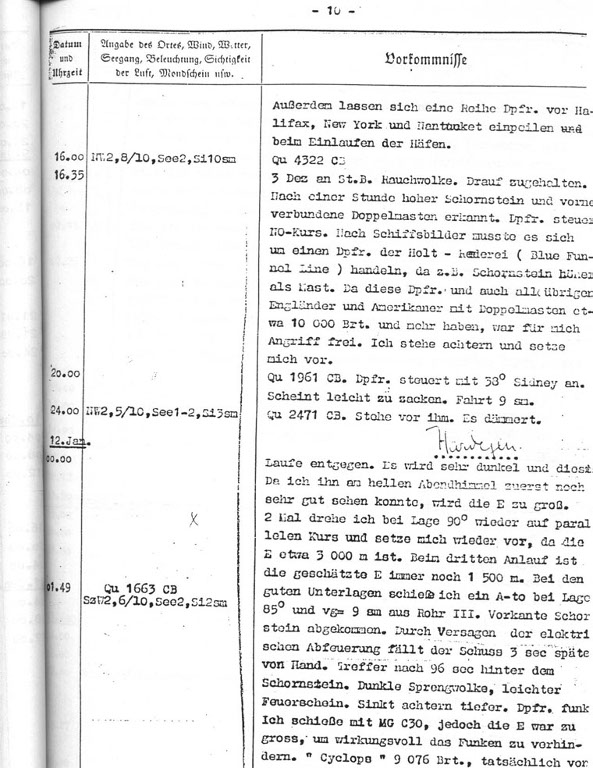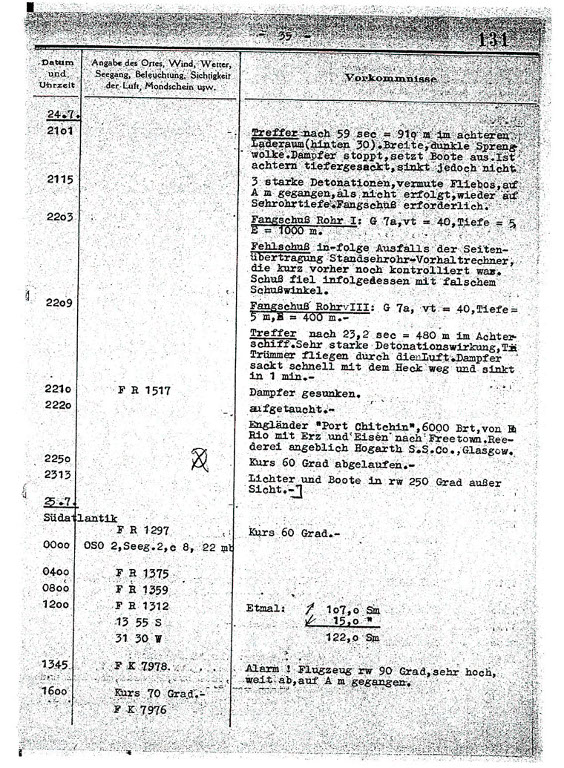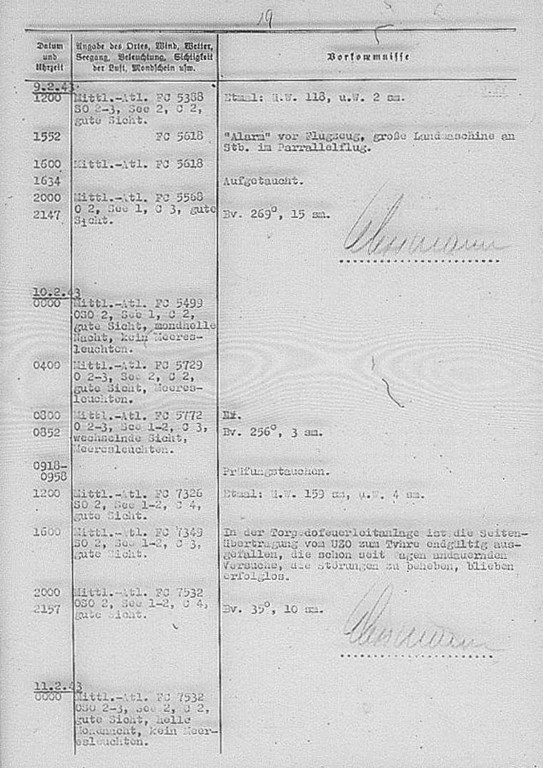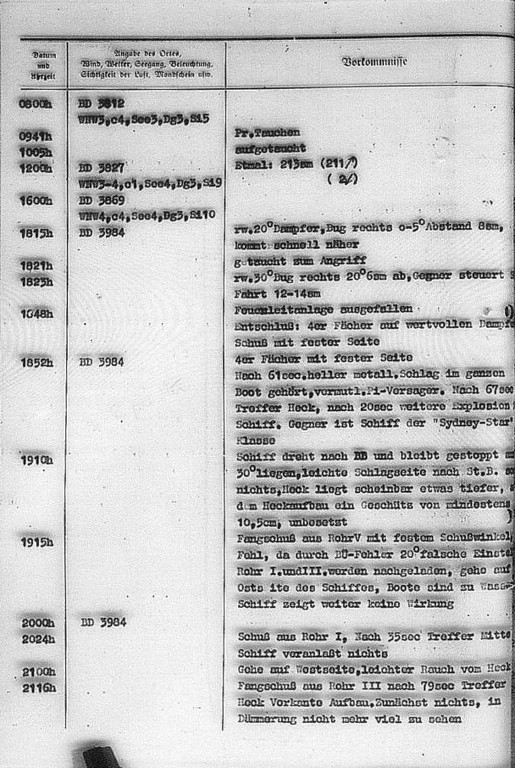Malfunctions of the torpedo fire control systems described in the War Diaries
The torpedo attacks descriptions in the U-Boat War Diaries, usually (beside the result: hit/miss) contained the attack data. Moreover, after each torpedo attack a dedicated report (Schussmeldung) was written down. This report contained all details of the attack. Based on these reports, the analysis of the attacks effectiveness could be made and in case of the unsuccessful attacks, the reason of failure could be determined.
However, the most interesting diaries entries (regarding the subject of this website) are those describing malfunctions of the torpedo fire control system and proceeding in such cases.
Several cases of the torpedo attacks conducted by means of the damaged fire control systems are described below.
The description of the usage of the fully-operational torpedo fire control system is available here.
U 48's attack on convoy HG-34F, 19 June 1940 (grid BE 9651)
Auf ersten und zweiten Dampfer der Westreiche angelaufen. E = etwa 1200 – 1000 m.
Torpedoschuß aus Rohr I fällt nicht.
UZO Übertragung zur R.W. ausgefallen. Kabel abgesoffen. Schuß aus Rohr IV nach Vorhalttabelle. Vorhalt zu groß! Vorne vorbei!
Abgedreht. Dabei und durch das durch Warten auf Fallen der Schüsse auf etwa 500 m an Schlußschiff herangekommen. Wir hören ihn während des Ablaufens heulen. Seitlich und hinter des Geleitzug keine Sicherung. Morseverkehr.
Die marine Warnung und grüne und weiße Sterne beobachtet. Außer Sicht vom Geleitzug vorgelaufen. Der Feger steht noch vorn, läßt sich anscheinend nicht aus der Ruhe bringen.
Die Dampfer haben sich inzwischen wieder in die Formation gefunden. Wieder angelaufen.
Schuß aus Rohr III fällt auf etwa 1000 m.
Abgedreht zu Heckschuß. Nach 114 Sek. = 1600 m traf der Schuß aus Rohr III einen überlappend stehendes Schiff das weiter entfernt war. Größe etwa 6500 t. Heckschuß ist Fehlschuß, da in der Eile Vorhalt nicht in G.A. eingedreht. Abgelaufen.
Photo 1. The U 48's War Diary, 19th June 1940, the entry describes the attack on the convoy HG-34F [1]
Ran toward the first and second steamers in the western column. Range: 1200 - 1000 meters.
Torpedo does not leave the tube I.
The transmission link between night sight UZO and torpedo calculator fails. Cable flooded. Shot from tube IV from deflection table. Deflection angle too great! Torpedo passed ahead!
Turned away. At the same time, by waiting on taking the attack position approached to approximately 500 meters from the closing ship, we hear him howling while moving off. Laterally and behind the convoy there is no screen. Morse traffic.
A naval warning of green and white stars observed. Maneuvered ahead out of sight of the convoy. The sweeper is still positioned ahead, apparently cannot be disturbed.
In the mean time the steamers are again found in the same formation. Again approached.
Shot from tube III taken at about 1000 meters.
Turned for a stern shot. After 114 seconds = 1600 meters the shot from tube III hit an overlapping ship that was further away. Size about 6500 tons. Stern shot missed, because in the rush the gyro angle not set at the gyro angle setting gear. Ran off.
Photo 2. Schussmeldung on U 48's torpedo attack on 19th June 1940 [1]
Photo 3. Schussmeldung on U 48's torpedo attack on 19th June 1940 [1]
Photo 4. Schussmeldung on U 48's torpedo attack on 19th June 1940 [1]
Photo 5. Schussmeldung on U 48's torpedo attack on 19th June 1940 [1]
During the first attack approach it was intended to launch two torpedoes. However, one of them did not leave the tube I (the torpedo was not a Rohrlaufer, i.e. a torpedo with running engine that got stuck in the tube, most likely the launching gear failed). While preparing the second torpedo to launch (from tube IV), it turned out that the target bearing from the UZO night sight was not transmitted to the torpedo calculator (because of damaged wire). In such a situation, it was decided to abandon the usage of the torpedo calculator and to launch torpedoes without gyro-angling (by aiming with the boat) with calculating tables. Accordingly, the UZO night sight was set to the bearing equal to 345°. The angle between the sight line and course of the straight (without gyro-angling) running torpedo was equal to 15°, i.e. the value of calculated deflection angle. The torpedo was launched when the target appeared in the sight graticule. In the War Diary was written that deflection angle was too great and torpedo passed ahead of the target. It seems that in a hurry, the mistaken value was read from the calculating tables: for firing data recorded in the firing report (Schussmeldung) (target speed 9 knots, angle on the bow 90°), the deflection angle should be 13°, while in the fact the value 15° was used. If the target was 1000 meters away (as recorded in the firing report), the torpedo passed about 35 meters ahead of the target.
The next attack (one hour later) was conducted by means of the partially operational fire control system, according to the procedure described in the chapter II A (Feste Seite). This procedure was provided in case of malfunction of the target bearing transmission link between night sight/periscope and torpedo calculator. As a fixed bearing angle, the value 0 was used (i.e. aiming at the bow net cutter). According to this procedure, the target data as well as the fixed target bearing equal to 0 were set at the torpedo calculator. Using these values, the device calculated the gyro-angle value equal to 16° (port), which was automatically transmitted and set (by means of the gyro-angle receiver in the bow torpedo room) at torpedoes. When the target was directly ahead of the U-Boat, visible above the bow net cutter (i.e. at bearing 0 for which the gyro-angle was calculated), the torpedo was launched.
The first torpedo launched in this way from the tube III hit the Norwegian motor merchant Tudor.
The next torpedo to the same target was intended to be launched in the same way from the stern torpedo tube. When the boat turned around, the torpedo was launched, but in a hurry the order for setting the target bearing 180° at the calculator was not issued (and most likely the gyro-angle receiver in the stern torpedo room was not enabled too). As a result, the torpedo was launched with the gyro-angle value equal to 0 (should be equal about 12°).
The next torpedo attacks that night were conducted in the same way. During the next day, the target bearing transmission wire was repaired and the subsequent attacks were conducted by means of the fully operational torpedo fire control system.
U 69's attack on not escorted, British steamer Tewkesbury, 21 May 1941 (grid ES 5554)
Angriff angesetzt!
Bug rechts, Lage 90°, Vg 10 sm, Ato 3 m.
Laufzeit 52 sec = 1070 m. Ohne Anlage, da G.A.
Stellzeug unklar!
Treffer: Vorn 20.
Photo 6. The U 69's War Diary, 21st May 1941, the entry describes the attack on the ship Tewkesbury [2]
Attack initiated!
Angle on the bow: 90°, bow right, target speed 10 knots, the wet-heater torpedo running depth 3 meters
Running time 52 seconds, 1070 m. Shot without fire control system, because
the gyro-angle setting gear is not working.
Hit, forward 20 meters.
Photo 7. Schussmeldung on U 69's torpedo attack on 21st May 1941 [2]
Photo 8. Schussmeldung on U 69's torpedo attack on 21st May 1941 [2]
During this attack it turned out that gyro angle setting gears were out-of-order, so the gyro angle calculated by torpedo calculator could not be continuously set at torpedoes. In such a situation, it was decided to launch torpedo according to the procedure described in the chapter II B (Fester Schusswinkel) provided in case of such malfunction (although in the War Diary there is an entry: Ohne Anlage - without torpedo fire control system - content of the Schussmeldung clearly suggests Fester Schusswinkel procedure). According to this procedure, the target data were set at the torpedo calculator, and then by turning the target bearing knob, one tried to achieve the gyro angle equal to 0 as a result (this value of the gyro angle was also pre-set at torpedoes). Then, from the corresponding calculator dial, the target bearing (346°) was read off and passed to the bridge. The UZO night sight was set to this bearing and when the target appeared in the sight graticule, the torpedo was launched. As a result of this attack, the torpedo hit the stem of the British steam merchant Tewkesbury.
Just as a side note, the earlier attack on that day and the later attack (on 22nd May 1941) were also conduced without gyro-angling. However, the torpedoes were aimed to the stationary targets, so the deflection angle was 0.
The next attack (on 31st May 1941) was conducted with gyro-angling. It implies that gyro angle setting gears were repaired till then.
U 109's attack, 19 January 1942 (grid BA 9965)
Angelaufen zum Mehrschuss aus Rohr II und III.
S c h u s s aus Rohr II und III:
Eingestellte Werte:
Gegnerfahrt: 8 sm/h
Gegnerlage: 80 Bug links
Entfernung: 800 m.
Rohr III Schuss nicht gefallen, da Abfeuerungslampe im Bugraum nicht aufleuchtete und B.U.-Versager.
Fehlschuss!
Beim Seitenvergleich zwischen UZO u. Vorhaltrechner wurde ein Übertragungsfehler von 5° festgestellt, der vom Schützen beim Schuss berücksichtigt werden musste. Fälschlicherweise verlegte der T.O. den Abkommpunkt nach der verkehrten Seite.
Der UZO-Kopf war während der Letzten Tage vereist, und er musste beim Vergleich gewaltsam bewegt werden. Dabei scheint sich dieser Fehler von 5° eingedreht zu haben.
[…]
Angelaufen zum Schuss aus Rohr III (Ato)
S c h u s s aus Rohr III:
Eingestellte Werte:
Gegnerfahrt: 6 sm/h
Gegnerlage: 60 Bug links
Entfernung: 800 m.
Fehlschuss!
Laufzeit: Nach 6 Min. 58 Sec. Wurde im
Boot eine Torpedodetonation wahrgenommen, wahrscheinlich ist der Torpedo nach Ablauf seiner Laufstrecke auf flachem Wasser hoch gegangen.
Dampfer muss während des Anlaufs noch mehr mit der Fahrt heruntergegangen sein. Beim Abdrehen wird sofort Rohr VI klar gemacht, es sieht aus, als hätte der Dampfer gestoppt.
S c h u s s aus Rohr VI:
Eingestellte Werte:
Gegnerfahrt: 0 sm/h
Gegnerlage: 90 Bug links
Entfernung: 500 m.
Fehlschuss!
Schuss fielt mit falschem Schusswinkel.
Die Seite war nach dem Umschalten auf Heckrohre noch nicht nachgelaufen.
[…]
Setze mich vor zum Heckschuss aus Rohr V und laufe mit einer Maschine K.F., um Gegner ganz langsam einwandern zu lassen. Gegner wandert nur sehr langsam ein. Gegner läuft höchstens 4 sm/h.
S c h u s s aus Rohr V:
Eingestellte Werte:
Gegnerfahrt: 4 sm/h
Gegnerlage: 100 Bug links
Entfernung: 1500 m.
eingest. Tiefe am Torpedo = 2 m.
Auch dieser Schuss trifft nicht; obwohl die Schussunterlagen genau ermittelt waren.
Dieser Anlauf wurde mit festem Schusswinkel vom UZO geschossen. Wie später festgestellt, ist vom T.W.L. falscher Seitenwert am Vorhaltrechner abgelesen und an den T.O. gemeldet worden.
Auch dieser Torpedo muss zu allem Überfluss am Ende seiner Laufstrecke detoniert sein, denn im Boot wurde etwa nach 6 Min. eine Detonation wahrgenommen.
Ich gebe nun kein Vertrauen mehr zur Feuerleitanlage und ich entschliesse mich zu einem Schuss über den Netzabweiser mit festem Schusswinkel und festrer Seite 0°.
Setze mich etwas ab und vor zum nächsten Anflauf. Bb. Voraus ein weisses Licht, kommt schnell näher. Schmale Silhouette ist zu erkennen. Muss schnell zum nächsten Anlauf andrehen. Der Dampfer muss fallen!!
S c h u s s aus Rohr I über Netzabweiser:
Bin bis auf 500 m an den Dampfer herangegangen. Eingestellte Werte:
Gegnerfahrt: 4 sm/h
Gegnerlage: 90 Grad, Bug links
Entfernung: 500 m.
eingest. Tiefe am Torpedo = 3 m. da hohe lange Dünung.
Torpedo kommt nach 100 m aus des Wasser, läuft ein Stück als Oberflächenläufer und geht kurz vor dem Dampfer auf Tiefe.
Auch dieser Torpedo traf sein Ziel nicht.
Vermute, dass er den Dampfer untersteuert hat.
[…]
UZO überholt. Feuerleitanlage überprüft.
[…]
Aufgetaucht. Nochmals UZO an Hand der Nullmarke am Bug kontrolliert. Dabei festgestellt: UZO steht in Nullstellung in Mittschiffsrichtung. Fehler muss als in Übertragung vom UZO zum Vorhaltrechner liegen. Ausser Ausfall der Seitenübertragung ist Anlage klar.
Photo 9. The U 109's War Diary, the entry describes the attack on 19th January 1942 [3]
Photo 10. The U 109's War Diary, the entry describes the attack on 19th January 1942 [3]
Photo 11. The U 109's War Diary, the entry describes the attack on 19th January 1942 [3]
Photo 12. The U 109's War Diary, the entry describes the attack on 19th January 1942 [3]
Approached to fire multiple shots from tubes II and III.
Fired torpedo from tube II and III:
Firing data:
target speed: 8 knots
angle on the bow: 80, bow left
distance: 800 meters.
Tube III did not fire because the firing control lamp did not light up and the verbal command transmission failed.
Missed!
During comparison of the bearing transmitted by UZO and received by torpedo calculator a transmission error of 5° was noticed which had to be considered by the aimer when firing. However, the aimer erroneously corrected this error to the wrong side.
The UZO mechanism had been iced up in the last days and had to be moved with force for the aiming procedure, probably causing this 5° error.
[…]
Approached again to fire tube III (wet-heater torpedo)
Fired torpedo from tube III:
Firing data:
target speed: 6 knots
angle on the bow: 60, bow left
distance: 800 meters.
Missed!
After 6 minutes 58 seconds a torpedo detonation was heard in the boat, probably the torpedo exploded at the end of its run in shallow waters.
Steamer must have slowed down further during our approach. When turning away we immediately made tube VI ready, it looks like the steamer stopped.
Fired torpedo from tube VI:
Firing data:
target speed: 0 knots
angle on the bow: 90, bow left
distance: 500 meters.
Missed!
The torpedo was fired with the wrong gyro angle.
The torpedo calculator did not adjust the bearing after switching to the stern tubes.
[…]
I overtake the target to fire a stern torpedo from tube V and then wait with one engine at Slow-Ahead to let him run slowly into my line of fire. Enemy is approaching very slowly, running at 4 knots at most.
Fired torpedo from tube V:
Firing data:
target speed: 4 knots
angle on the bow: 100, bow left
distance: 1500 meters.
torpedo running depth: 2 meters.
This shot missed as well, despite exactly calculated firing data.
In this approach we fired with a fixed gyro angle from the UZO. Later we realized that the operator of the torpedo calculator read off a wrong value for bearing from the calculator and reported it to the aimer.
The torpedo detonated apparently at the end of its run because one could hear a detonation in the boat after about 6 minutes.
I've lost all confidence in the fire control system and decide to fire the next shot directly aimed with the net deflector on a fixed gyro angle and fixed bearing of 0°.
Headed off a bit to overtake for the next approach. Sighted a white light on port side ahead, comes closer fast. After recognized a slim silhouette we have to turn fast for the attack. This steamer has to fall!
Fired torpedo from tube I aimed with the net deflector:
Went closer to the steamer to a distance of 500 meters. Firing data:
target speed: 4 knots
angle on the bow: 90, bow left
distance: 500 meters.
torpedo running depth: 3 meters due to high and long swell
After 100 m the torpedo comes out of the water, runs a distance as surface runner and dives shortly before reaching the steamer.
This torpedo missed the target as well.
Assume that it passed underneath the steamer.
[…]
Overhauled the UZO and checked the torpedo data computer.
[…]
Surfaced. Again checked the UZO with the zero marker on the bow. In so doing noticed: UZO aims in the amidships direction when in the neutral position. The error has to be in the transmission from the UZO to the torpedo calculator. The fire control system is ready except the bearing transmission.
On 19th January 1942, near the southern coast of Nova Scotia, U 109 conducted five attacks on an unknown ship.
During the first approach it was intended to launch two torpedoes.
First of them was not launched because of failure of the electrical firing system, the respective control lamp indicating that firing lever was triggered also did not lit up (in response to lighting the lamp up, the torpedo tube operator should launch torpedo manually). The function of the control lamps was backed up by verbally passed orders through the voice tube or internal telephone (B.Ü. - Befehl Übertragung, e.g. Rohr eins... los!). However in this case, the passing orders also failed.
The second torpedo missed the target because wrong target bearing was transmitted to the torpedo calculator. Due to malfunction of the target bearing transmission system between UZO night sight and torpedo calculator, the value received by calculator varied by 5° from real value indicated by UZO. This flaw was observed before the attack, so the error was intended to be compensated by suitable adjustment of night sight. However, during the attack, the First Watch Officer took the lead to the opposite side, so the error was not compensated but increased to value of 10° and, as a result, the incorrect gyro angle was calculated.
The wet-heater torpedo launched during the second approach missed the target because of incorrect attack data (overestimated target speed).
During the third approach the torpedo was intended to be launched from the aft torpedo tube. After turning the stern toward the target and switching to the aft tubes (i.e. connecting the torpedo calculator with the gyro angle receiver in the aft torpedo room and switching the parallax to the aft), the UZO night sight was turned toward the stern to aim the target and then torpedo was launched. Unfortunately, due to electro-mechanical construction of the calculator, rapid change of the target bearing by about 180° required about 20 seconds to set the new bearing value by internal servo-motors. The torpedo was launched before it happened, thus it run with incorrect gyro angle (in other words, it was launched before the calculations were completed).
During the fourth approach aft torpedo tube was used also. This time, because of the errors in target bearing transmission, it was decided to use the procedure described in chapter II B (Fester Schusswinkel), i.e. attack with the fixed gyro angle. In such case, target data were set at the torpedo calculator, and then the target bearing was adjusted manually (by means of the hand knob) to get desired gyro angle (which was also pre-set at the torpedoes). Then, from the corresponding calculator dial, the target bearing was read off and passed to the bridge. The UZO night sight was set to this bearing, and when the target appeared in the sight graticule, the torpedo was launched. However, during this procedure, the calculator operator read off the incorrect value and, as a result, the sight was set to the false bearing and torpedo was launched at the wrong time.
During the fifth approach it was decided not to use UZO night sight (to avoid any errors related with it). Instead of this, the procedure described in the chapter II A (Feste Seite), i.e. attack with the fixed target bearing (equal to 0) was used. In other words, the torpedo was to be launched when the target passed above the bow net cutter. The target data and fixed target bearing equal to 0 were set at the torpedo calculator. The calculated gyro angle was set at the torpedoes. In this case, the torpedo passed beneath the target due to malfunction of the depth-keeping gear.
During the subsequent fire control system overhaul it was found that the target bearing transmission system between UZO night sight and torpedo calculator was out-of-order. The other parts of the torpedo fire control system were fully operational.
U 123's attack on not escorted, British steamer Cyclops, 12 January 1942 (grid CB 1663)
Bei den guten Unterlagen schieße ich ein A-to bei Lage 85° und vg= 9 sm aus Rohr III. Vorkante Schornstein abgekommen. Durch Versagen der elektrischen Abfeuerung fält der Schuss 3 sec später von Hand. Treffer nach 96 sec hinter dem Schornstein.
Photo 13. The U 123's War Diary, 12th January 1942, the entry describes the attack on the ship Cyclops [4]
With firing good data I launch a wet-heater torpedo from tube III. Angle on the bow 85° and target speed 9 knots. Aimed at the leading edge of the funnel, but the electrical firing system failed and the shot was fired manually 3 seconds later. Hit after 96 seconds behind the funnel.
During this attack on the British steam merchant Cyclops, due to malfunction of the electrical firing system, the torpedo was launched manually, in response to lighting the control lamp up, or in response to the voice command (in this case, the procedure that failed during first attack of U 109, succeeded).
U 123's attack, 23 March 1942 (grid CB 8172)
Es ist ein ganz moderner Motortanker mit kurzen Masten u. niedrigem, dicken Schornstein. Änlich “Norness” u. ich schätzte ihn auf 9500 brt. Auf eine e = 500 – 600 m schiesse ich einen Bug ato, Tiefe 3 m, vg = 10,5 sm, Lage 70°, Da der Horchraum meldet: Torpedo läuft, drehe ich hart ab nach St.B. Fehlschuss war auf die geringe E unmöglich. Es erfolgt nichts. Da meldet der Bugraum: Rohrläufer! Durch B.Ü. Fehler war es untergeschnitten, denn sonst hätte ich bei Lage 80° oder 90° noch einen 2. Aal schiessen können, der fertig war. Ich drehe nun hart weiter, um einen ebenfalls fertigen Heckaal zu schiessen. Da ich jedoch nun auf etwa 300 m breit zum Tanker lag, hatte er mich endlich doch gesehen und drehte hart ab nach St.B., Lage 180°. Befehle: Halt, sichern. Nach einiger Zeit wird gemeldet, dass Rohr V. Schuss gefallen ist. Der Gast hatte selbständig von Hand losgemacht, weil er auf das „Los“ wartete und glaubte es im Sprachrohr gehört zu haben. Auf den Befehlsgeber hatte er nicht geachtet. Der Aal sauste also irgendwohin in die Gegend. Der Rohrläufer war ¼ m im Rohr vorgerutscht und wurde dann mit Minenausstoss ausgestossen.
Photo 14. The U 123's War Diary, the entry describes the attack on 23rd March 1942 [5]
It is a very modern motor tanker with short masts and a low big funnel. Similar to "Norness" and I estimate about 9500 GRT. From a distance of 500 to 600 meters I fire one wet-heater torpedo from the bow tube, running depth 3 meters, target speed 10.5 knots, angle on the bow 70°. When the hydrophone operator reported that the torpedo was running I turned hard to starboard. A miss was not possible from this close distance. Nothing happened. Report from bow torpedo room: tube runner! Due to a misunderstanding the boat had already turned too far to fire a prepared second torpedo on angle on the bow 80° or 90°. I continue the hard turn to fire an also prepared stern torpedo. I was now showing my broadside to the tanker from a distance of 300 meters, so he finally saw me and turned away to starboard, angle on the bow 180°. Ordered: stop attack and secure the tubes. After some time it is reported that the torpedo was fired from tube V. The crewman had fired it manually on his own because he was waiting for the order to fire and believed he heard it in the voice tube. He did not look at the torpedo order telegraph. The torpedo was heading to anywhere. The tube runner had moved ¼ m in the tube and was jettisoned with the mine discharge gear.
During this attack an unintentional torpedo launch from the aft tube occurred. It was result of misunderstanding while passing orders. The torpedo tube operator who waited for the order to launch, did not hear the order to secure the tubes. When he heard through the voice tube the order similar to "Los!", he manually launched the torpedo. One can note the reference to the torpedo order telegraph which was installed on some early-war U-Boats.
U 123's attack, 2 April 1942 (grid DC 1196)
Schuss Rohr VI. bei Lage 100°. Da die vg mir doch noch geringer schien, kam ich achterer Mast ab. Da viel auch noch die elektrische Abfeuerung aus und der Schuss fiel 3 sec zu spät von Hand. Die Visierlinie zeigte auf den Schornstein. Da es ein grosser Winkel war hatte ich sofort das Gefühl eines Fehlschusses und befehl auf Artilleriegefechtsstationen. Der Aal steuerte jedoch richtig den Winkel ein und nach 40 sec meldete der Horcher, dass Torpedogeräusch ausgesetzt hat, ohne Aufschlag zu hören. Es war genau die Schussentfernung. Die Schussauswertung ergab, dass der Aal hätte treffen müss. Es war der Tanker „Liebre“ von 7057 Brt, der nach Gröner 10 sm läuft. Alle Fehler, wie falsche vg, Lage kann stumpfer gewesen sein und Parallaxfehler durch falsche E ergeben eine Treffpunktsverlegung nach vorne. Bei dem achteren abkommpunkt und der Abfeuerungsverzögerung hätte es sich also günstig auswirken müssen. Da der Horcher bei den übrigen Fehlschüssen die Torpedos bis zum Ende der Laufstrecke horchte, hier aber nach 40 sec nichts mehr, vermute ich, dass der Tanker ein Netz gehabt haben muss.
Photo 15. The U 123's War Diary, the entry describes the attack on 2nd April 1942 [5]
Fired torpedo from tube VI on angle on the bow 100°. It seemed to me that the target speed was even slower I aimed for the aft mast. But then the electrical firing mechanism failed too and the torpedo was launched 3 seconds later manually. The line of the sight was at the funnel. Because it was a big angle right away I felt it would miss and ordered the men to prepare an artillery attack. However the torpedo steered the correct angle and after 40 seconds the man at the hydrophone reported that the sound of the torpedo stopped without an impact being heard. It was exactly at the firing distance. An analysis showed that the torpedo would have hit. According to Gröner it is the tanker "Libre" (7057 GRT) which is running 10 knots. All the mistakes, like the wrong target speed, the angle on the bow which should have been more obtuse and the parallax error from an incorrect distance estimate would shift the impact point more ahead. The aiming point aft and the delay on firing would have had a favorable effect for us. Because the man at the hydrophone could hear the torpedoes of the other misses until the end of their run but in this case heard nothing after 40 seconds, I assumed that the tanker is equipped with nets.
In case of this attack, due to malfunction electrical firing system, the torpedo was launched manually with 3 seconds of delay. According to Kptlt. Hardegen, the torpedo should hit the target (whose speed was overestimated initially, but change of the aiming point in the last moment and delayed launch of torpedo had to compensate this error), however tanker was fitted with torpedo nets.
U 172's attack on not escorted, British steamer Fort Chilcotin, 24 July 1943 (grid FB 1517)
Fangschuß Rohr I: G 7a, vt = 40, Tiefe = 5, E = 1000 m.
Fehlschuß in-folge Ausfalls der Seitenübertagung Standsehrohr-Vorhaltrechner, die kurz vorher noch kontrolliert war. Schuß fiel infolgedessen mit falschem Schußwinkel.
Photo 16. The U 172's War Diary, 24th July 1943, the entry describes the attack on the ship Fort Chilcotin [6]
Coup de grâce from tube I: wet-heater torpedo, angle on the bow 40°, running depth 5 meters, distance 1,000 meters.
Miss due to the failure of bearing transmission from the attack periscope to the torpedo calculator, which had been checked shortly before. Because of this wrong gyro angle.
This torpedo attack (on British steam merchant Fort Chilcotin which detached from the convoy JT-2) failed due to undetected malfunction of the target bearing transmission system. The torpedo calculator received incorrect target bearing and, as a result, wrong gyro angle was calculated.
U 482's on convoy HX-305, 8 September 1944 (grid AM 5387)
Im Boot wird mit blossem Ohr starkes Rauschen gehört, genau wie am 2.9. als der Geleitzug überlief.
Mehrere Horchpeilungen achteraus und in 30, 50, 80 Grad, Dampfergeräusche.
Auf Gefechtsstationen, Auf Sehrohrtiefe.
Im Angriffssehrohr nur eben Schattenmassen auszumachen. Übergangen auf Zentralsehrohr. Hier ist Helligkeit für Unterwasserangriff, ausreichend. Boot steht tatsächlich wieder mitten in Einlaufgeleit, auf gleichen Kurse mitlaufend die nächststehenden Dampfer sind gut auszumachen ein Gesamtüberblick über Formation und Stärke Geleit jedoch nicht zu gewinnen.
Schuss aus Rohr III (Ato) auf Frachter 5000 BRT
Schussunterlagen: Tiefe 6, Torpedogeschw. 40,
Vg. 8, Lage rechts 110 E. -8,
Abkommpunkt Mitte, Pi I
Treffer 0 min. 42 sec. Treffer nicht beobachtet.
Schuss aus Rohr I (T 3) auf Frachter 5000 BRT.
Schussunterlagen: Tiefe 6, Vg 8, Lage links 120,
E.-8 Abkommen Mitte, MZ ein.
Fehlschuss da am Vorhaltrechner noch Torp. Geschw. 40 eingestellt war. Fehler von mir, da bei Wertegeben vergessen.
Photo 17. The U 482's War Diary, 8th September 1944, the entry describes the attack on the convoy HX-305 [7]
A loud rushing is heard with the naked ear in the boat, exactly as on 2 September when the convoy overran.
Several sound bearings astern and in 30°, 50°, 80°, steamer sounds.
To Action stations, to periscope depth.
In the attack periscope only smooth shadow masses are distinguished. Switched over to the control room periscope. Here it is bright enough for a submerged attack. In fact the boat is again in the middle of an inbound convoy, ran along on the same course, the nearest steamers are easily distinguished, but failed to gain an overall view of the formation and strength of the convoy.
Shot from tube III (wet-heater torpedo) on freighter 5000 GRT
Firing data: torpedo running depth 6 meters, torpedo speed 40 knots
target speed 8 knots, angle on the bow 110, bow right, distance 800 m
aim point center, pistol type: Pi 1
Hit after 42 seconds, no effect observed
Shot from tube I (electric torpedo) on freighter 5000 GRT
Firing data: torpedo running depth 6, target speed 8, angle on the bow 120, bow left
distance 800 meters, aim point center, influence pistol
Miss because the torpedo speed still set to 40 knots at the torpedo calculator. Error by me, because I forgot to specify the value.
During this attack first (wet-heater) torpedo was launched with the speed of 40 knots. The same value of torpedo speed was also set at torpedo calculator. Because the hit was not observed, it was decided to launch second torpedo. This torpedo was electrically driven and could run with speed 30 knots only. However, it was forgotten to update the torpedo speed at torpedo calculator, so calculated value of deflection angle was to small (β ≈ 10° instead of ≈ 13°) and torpedo passed behind the target.
U 518's attack on not escorted, Brazilian motor merchant Brasiloide, 18 February 1943 (grid FJ 8524)
10.02.43
In der Torpedofeuerleitanlage ist die Seitenübertragung vom UZO zum Tvhre endgültig ausgefallen, die schon seit Tagen andauernden Versuche, die Störungen zu beheben, blieben erfolglos.
Photo 18. The U 518's War Diary, 10th February 1943, the entry describes the malfunction of the torpedo fire control system [8]
The part of the torpedo fire control system responsible for transmitting the target bearing from UZO night sight to the torpedo calculator has failed permanently, for days ongoing attempts to repair the malfunction have been unsuccessful.
18.02.43
Angelaufen zum Buganlauf. Wegen Ausfall der Seitenübertragung vom UZO zum Tvhre muß mit fester Seite geschoseen werden.
[…]
Zweierfächer aus Rohr I u. IV.
Feste Seite 0, Vg. 12, Gamma links 80, E 3000, Tiefe 2.
Photo 19. The U 518's War Diary, 18th February 1943, the entry describes the attack on the ship Brasiloide [8]
Photo 20. The U 518's War Diary, 18th February 1943, the entry describes the attack on the ship Brasiloide [8]
Ran in for an attack with bow tubes. Due to failure of the target bearing transmitting system must shoot with fixed target bearing.
[…]
Two-torpedo salvo from tubes I and IV.
Fixed target bearing 0, target speed 12, angle on the bow 80, bow left, distance 3000, torpedo running depth 2.
Due to malfunction of the target bearing transmission system between UZO night sight and torpedo calculator, during the attack (on Brazilian motor merchant Brasiloide) the procedure described in chapter II A (Feste Seite) – attack with the fixed target bearing equal to 0, was used. Target data and fixed target bearing equal to 0 were set at the torpedo calculator. The calculated gyro angle was set at torpedoes. The torpedoes were launched when target appeared in the sight (which was set at bearing 0) graticule.
U 615's attack on non escorted, British motor merchant Empire Star, 23 October 1942 (grid BD 3984)
rw. 20° Dampfer, Bug rechts 0-5° Abstand 8 sm, kommt schnell näher
getaucht zum Angriff
rw. 30° Bug rechts 20° 6 sm ab, Gegner steuert S, Fahrt 12-14 sm
Fueuerleitanlage ausgefallen
Entschluß: 4er Fächer auf wertvollen Dampfer
Schuß mit fester Seite
4er Fächer mit feseter Seite
Nach 61 sec. Heller metall. Schlag im ganzen Boot gehört, vermutl. Pi-Versager. Nach 67 sec
Treffer Heck, nach 20 sec weitere Explosion.
Gegner ist Schiff der “Sydney-Star” Klasse.
[…]
Fangschuß aus Rohr V mit festem Schußwinkel, Fehl, da durch BÜ-Fehler 20° falsche Einstellung.
Photo 21. The U 615's War Diary, 23rd October 1942, the entry describes the attack on the ship Empire Star [9]
Steamer true bearing 20°, angle on the bow 0-5°, bow right, distance 8 nm, comes quickly closer, dived to attack.
True bearing 30°, angle on the bow 20°, bow right, 6 nm away, target steers southerly course, speed 12-14 knots.
Torpedo fire control system fails.
Decision: 4-torpedo salvo on a valuable steamer.
Will shoot with fixed target bearing.
4-torpedo salvo with fixed target bearing
After 61 seconds a bright metallic impact heard in the entire boat, suspect a impact pistol failure. After 67 seconds hit aft, after 20 seconds another explosion in the ship.
Target is the "Sydney-Star" class.
[…]
Coup de grace from tube V with fixed target bearing, missed because of an order transmitting failure 20° incorrect setting.
During the attack on British motor merchant Empire Star it was found that the torpedo fire control system is out-of-order. Therefore, the procedure described in the chapter II A (Feste Seite), attack with fixed target bearing, was used. This suggests, that target bearing transmission system between periscope and torpedo calculator failed. The final shot (Coup de grace) missed the target, because the incorrect value 20° was set at torpedo calculator (most likely incorrect target bearing was set manually).
References:
[1] The War Diary for U 48's 6th patrol
[2] The War Diary for U 69's 3rd patrol
[3] The War Diary for U 109's 4th patrol
[4] The War Diary for U 123's 7th patrol
[5] The War Diary for U 123's 8th patrol
[6] The War Diary for U 172's 5th patrol
[7] The War Diary for U 482's 1st patrol
[8] The War Diary for U 518's 2nd patrol
[9] The War Diary for U 615's 1st patrol



